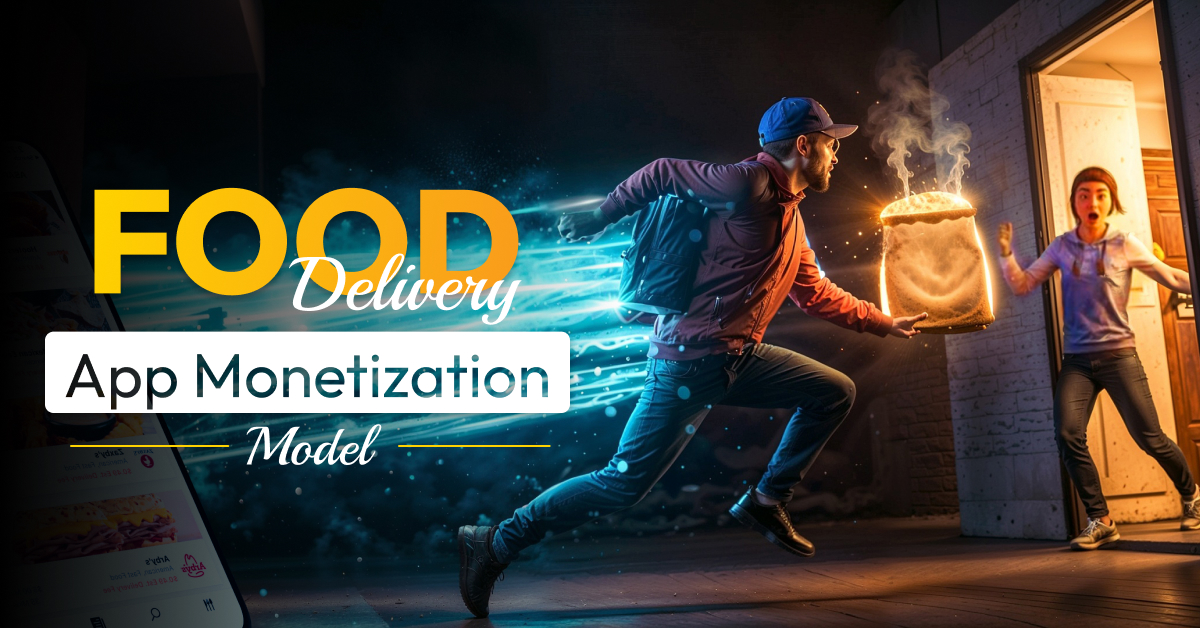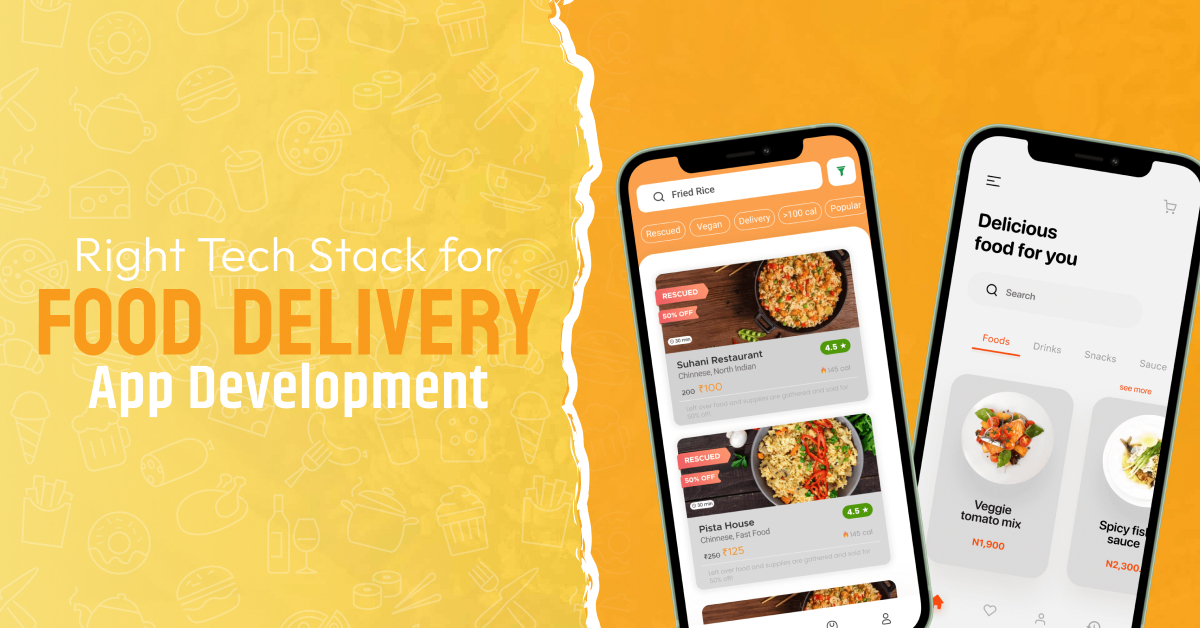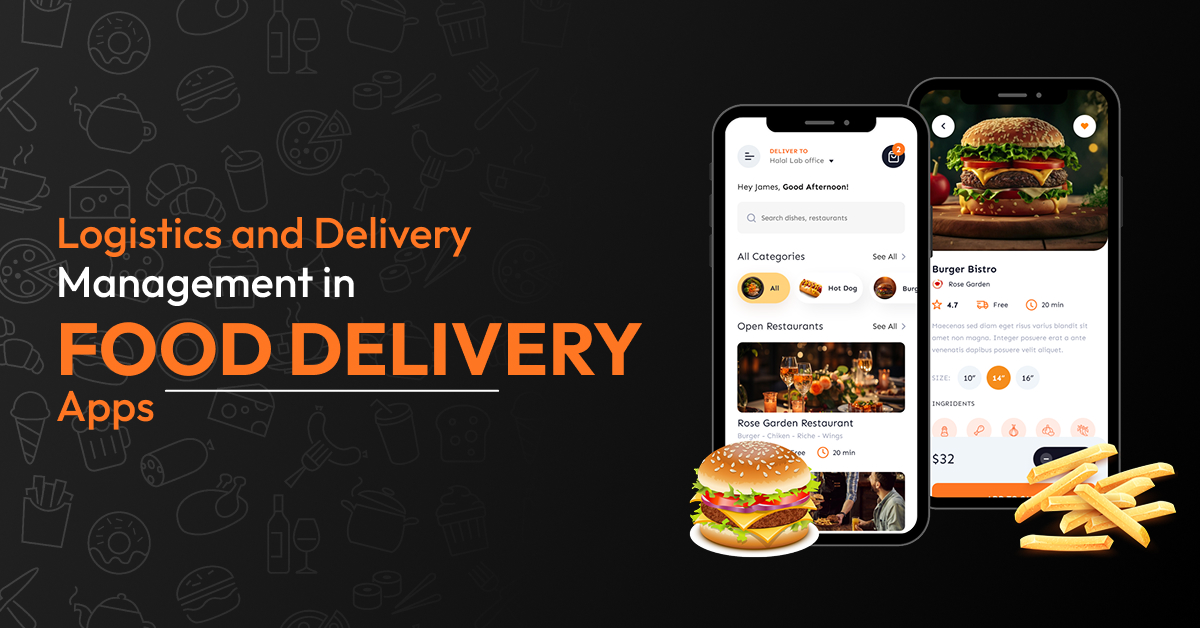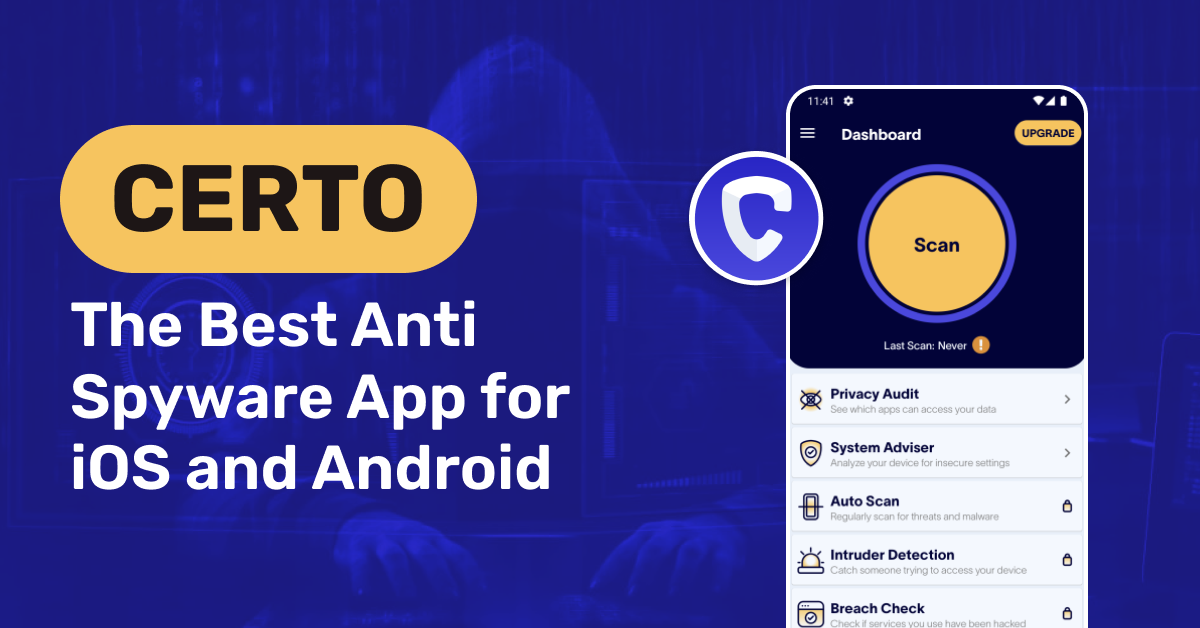“Monetize every food order”
It’s great to create a food delivery app. However, the main concern is how to make money from the app. Many businesses don’t know how to raise money from their application or website, which is why perfect applications are shut down.
But this time, you can get huge profits from your food delivery app with the right monetization model.
Have you heard about Zomato and Swiggy?
Definitely yes.
These are the best and popular food delivery applications, and they implement the right money-making strategies.
In this blog, we provide the best food delivery app monetization models that not only boost the overall sales but can also increase user engagement.
So, let’s make money!
Brief Introduction: Food Delivery App Monetization Model
With the increasing expansion of online meal ordering, food delivery applications have emerged as a lucrative revenue model of food delivery apps. However, creating a fantastic app is only half of the equation—monetization is essential for long-term success.
A well-thought-out food delivery app monetization strategy enables platforms to earn money through commissions, delivery fees, subscriptions, and in-app promotions, assuring profitability and sustainability in a competitive industry.
- The global online food delivery market is projected to reach $500 billion by 2030.
- In 2024, over 2.5 billion people used food delivery apps globally.
- The online food delivery segment is growing at a CAGR of 10.3% from 2024 to 2030.
- In the U.S., the ARPU for food delivery apps is approximately $200 per user per year.
- DoorDash generated $8.6 billion in revenue in 2023.
- Uber Eats surpassed $11.2 billion globally in 2023.
Why is it Crucial to Monetize Your Food Delivery App?
Food delivery applications are becoming a need rather than a fad due to the explosive growth of online meal ordering. But having a feature-rich app isn’t enough; the platform’s sustainability and scalability depend on monetization. Here are seven strong arguments for why it’s essential to monetize food delivery apps:

1. Recover Development costs
Food delivery app creation necessitates a considerable initial investment, which includes design, coding, testing, and marketing. Monetizing your software means that you gradually recover the food delivery app development cost in Europe over time.
Without income production, long-term operations become difficult, and your company may endure financial losses before establishing momentum in the competitive market.
2. Ensure Long-Term Sustainability
Monetization delivers a consistent cash stream that keeps your app functioning smoothly for years. Without revenue, frequent upgrades, customer support, and server maintenance are unsustainable.
The robust monetization strategies for food delivery apps ensures company sustainability and scalability, preventing your food delivery service from failing after its first success or user acquisition.
3. Generate Scalable Revenue
As your user base expands, so will your income. Delivery fees, commissions, and subscriptions are popular monetization methods that scale well with usage.
This means you make more without incurring corresponding increases in running costs, allowing your mobile app development company to expand rapidly while retaining excellent profit margins and resource management.
4. Attract Investors and Partners
Investors look for apps with proven monetization models for food delivery apps. A viable business strategy not only draws finance but also allows for relationships with restaurants, logistics suppliers, and payment processors.
With a defined route to income, your food delivery service becomes a more appealing and dependable endeavor for stakeholders and partners.
5. Enhance the User Experience
Monetization is more than simply making money; it may also increase customer satisfaction. Offering premium services such as free delivery, loyalty awards, or speedier service via subscriptions offers value to customers.
These options enable consumers to personalize their experience, resulting in increased retention, engagement, and brand loyalty over time.
6. Improve Operational Efficiency
With consistent income, you may invest in improved infrastructure, optimize logistics and delivery management in food delivery apps, and attract talented employees.
This results in faster deliveries, fewer mistakes, and more customer satisfaction. A monetized app promotes ongoing improvement in service quality, allowing you to maintain a competitive advantage and constantly fulfill customer expectations.
7. Stay Ahead of Competitors
The meal delivery market is overcrowded and continuously changing. Monetization offers you the financial resources to invest on innovation, marketing, and distinctive features. This establishes your app as a market leader, guaranteeing that you are not just keeping up but also exceeding the competition in terms of growth and user confidence.
10 Popular Revenue Models in Food Delivery Apps
Food delivery apps thrive on diverse revenue models like commissions, delivery fees, subscriptions, and ads. These food delivery app business models ensure profitability, scalability, and sustainability while enhancing user experience. Choosing the right combination of monetization strategies is essential for long-term success in the highly competitive online food delivery market.
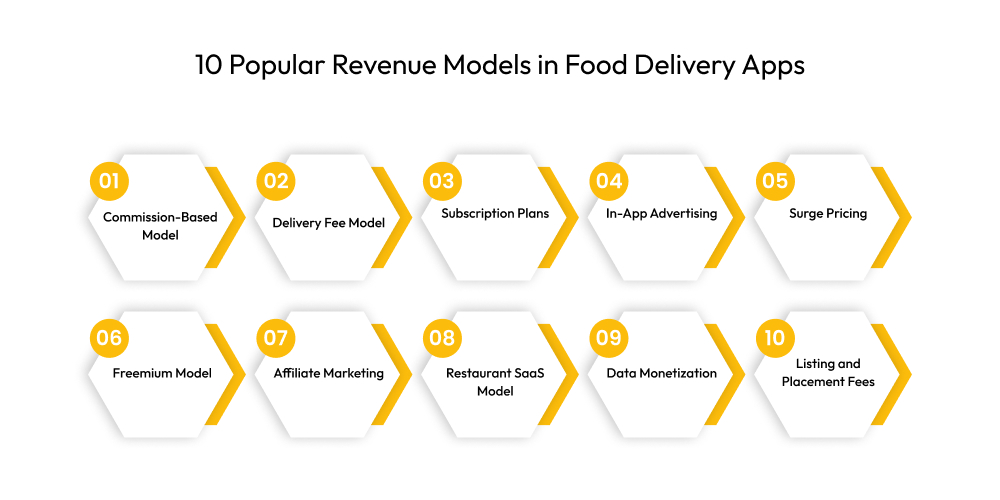
1. Commission-Based Model
This is the most prevalent income source, in which meal delivery apps charge restaurants a fee for each order placed through the platform—typically between 15% and 30%. It generates consistent revenue for the app’s owner while allowing businesses to access a larger consumer base, resulting in a win-win scenario for all stakeholders.
Aspect |
Details |
| Description | Apps charge restaurants 15–30% commission per order. |
| Benefit | Predictable income; 20–30% profit margin typical. |
| Cost | Minimal upfront cost; ongoing platform maintenance. |
| Example | Uber Eats, DoorDash, Zomato |
2. Delivery Fee Model
Apps charge customers a delivery fee per order, either as a flat rate or based on distance, time, or location. This fee can be dynamic, increasing during busy hours or poor weather. It helps cover driver costs and logistics while giving the business a direct income source from every order fulfilled.
Aspect |
Details |
| Description | Customers pay delivery fees ($1–$5/order). |
| Benefit | Direct revenue; covers delivery costs; 15–25% profit. |
| Cost | Logistics and driver management costs. |
| Example | Grubhub, Postmates |
3. Subscription Plans
Customers pay a monthly or yearly subscription to receive perks such as limitless free delivery, discounts, and special offers. This approach generates recurrent revenue and promotes client loyalty.
Food delivery app development solutions such as Uber Eats Pass and Zomato Gold leverage this concept to retain consumers and improve order frequency by providing continuous discounts.
Aspect |
Details |
| Description | Monthly fees ($5–$15) for perks like free delivery. |
| Benefit | Recurring revenue; improves customer retention; 70–80% profit on subscriptions. |
| Cost | Marketing and customer support for subscribers. |
| Example | Uber One, Zomato Gold |
4. In-App Advertising
Restaurants and companies may pay for in-app visibility with sponsored listings, banners, or highlighted placements. With significant app traffic, this becomes an effective marketing strategy. It enables food delivery systems to monetise user involvement without compromising the customer’s ordering experience, while also increasing restaurant exposure and revenues.
Aspect |
Details |
| Description | Restaurants pay for ad placements ($500–$5,000/month). |
| Benefit | Monetizes high traffic; 60–70% profit margin. |
| Cost | Development of ad platform and moderation. |
| Example | Swiggy, Deliveroo |
5. Surge Pricing
Prices climb during peak demand periods, holidays, or inclement weather conditions. This concept serves to balance supply and demand by motivating drivers while enhancing profitability.
While it may temporarily increase consumer expenses, it assures speedier delivery and keeps operations running smoothly during peak periods, boosting profitability.
Aspect |
Details |
| Description | Increased fees (10–50% higher) during peak demand. |
| Benefit | Maximizes revenue; boosts driver incentives; 20–35% profit. |
| Cost | Real-time pricing system and monitoring costs. |
| Example | DoorDash, Uber Eats |
6. Freemium Model
Basic software services are free, but enhanced features such as priority delivery or premium assistance require microtransactions. This technique entices customers with a free trial and gradually encourages upgrades.
It works well for apps aimed for tech stack for food delivery app development who value customization, speed, and convenience enough to pay more.
Aspect |
Details |
| Description | Basic service free; premium upgrades ($1–$10) paid. |
| Benefit | Encourages broad adoption; 40–60% conversion profit margin. |
| Cost | Development of premium features and customer service. |
| Example | Custom food delivery apps |
7. Affiliate Marketing
Food delivery apps collaborate with third parties to market credit cards, loyalty programs, and lifestyle items. When users join up or make a purchase via affiliate links, the app gets a commission. This approach has minimum cost and generates passive money, making it an appealing addition to the principal monetization method.
Aspect |
Details |
| Description | Earn 5–20% commission promoting third-party offers. |
| Benefit | Passive income with low overhead; 70–90% profit margin. |
| Cost | Minimal operational or technical costs. |
| Example | Local food apps with partners |
8. Restaurant SaaS Model
Apps offer ordering and delivery software to restaurants as Software-as-a-Service (SaaS). Restaurants pay a monthly fee to utilize the white-label software to manage their orders autonomously.
This B2B approach allows software developers to make a consistent income while also providing restaurants with unique, branded solutions for handling their online orders.
Aspect |
Details |
| Description | Monthly fees ($50–$500) for restaurant order management. |
| Benefit | Recurring B2B revenue; 60–75% profit margin. |
| Cost | Platform development and maintenance. |
| Example | ChowNow, Toast |
9. Data Monetization
Food delivery applications collect information about customer preferences, purchasing trends, and peak periods. According to the web development company, this anonymised data may be sold to advertising, restaurants, or research organizations.
It gives useful market data while maintaining privacy, and it adds another source of revenue without disrupting the customer experience or needing more user input.
Aspect |
Details |
| Description | Sell anonymized data insights ($1000+ monthly contracts). |
| Benefit | High-margin revenue; 80–90% profit. |
| Cost | Data security and analytics platform costs. |
| Example | Enterprise-level apps |
10. Listing and Placement Fees
Restaurants pay to appear at the top of search results or in the app’s highlighted areas. This improves their visibility and increases order volume. For the app owner, it’s a high-margin food delivery app revenue model that has no direct influence on client price, making it an effective method to monetize popularity and exposure.
Aspect |
Details |
| Description | Restaurants pay $200–$2,000 for featured spots. |
| Benefit | High-margin, scalable revenue. |
| Cost | Minimal additional operational costs. |
| Example | Swiggy, Zomato |
Choosing the Right Revenue Model for Your Food Delivery App
Selecting the ideal food delivery app monetization model is crucial for your food delivery app’s success. It determines your profitability, user experience, and business sustainability.
Whether it’s commission-based, subscription, or advertising-driven, the right revenue generation in food delivery apps aligns with your goals, market, and resources—ensuring long-term growth and competitive advantage in the industry.
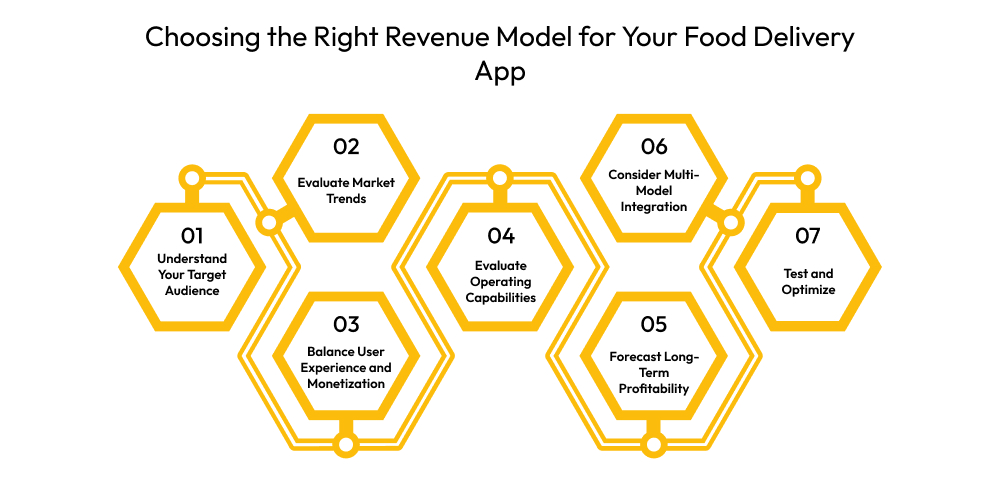
1. Understand Your Target Audience
Examine your consumers’ interests, ordering habits, and purchasing power. Are they price-sensitive or convenience-oriented? Hire a grocery app development company to understand their behavior, which allows you to choose food delivery app revenue models such as subscriptions for loyal users or delivery costs for occasional clients.
The more you understand your audience, the easier it is to provide monetization that meets their expectations and generates recurring income.
2. Evaluate Market Trends
Investigate the effective revenue strategies used by rivals in your target region. If commission-based models are prevalent, try differentiating through advertising or premium memberships.
Market trends reflect customer acceptance levels and monetization opportunities. Aligning with or developing beyond these trends will keep your app competitive and financially sustainable.
3. Balance User Experience and Monetization
The food delivery app monetization models must not harm the user experience. Excessive costs or invasive advertisements may repel users. Choose business models for food delivery apps like as freemium or value-added subscriptions to increase engagement.
A smooth experience fosters loyalty, which enables ongoing income creation. Monetization should seem like an improvement, not a hindrance to ordering meals quickly.
4. Evaluate Operating Capabilities
Each model needs a specialized infrastructure. A competent logistics system is required for a delivery charge model, and an in-app marketing system is required for advertising.
Evaluate your team’s ability to build and maintain these features. Choosing the food delivery app monetization strategies that is compatible with your operational capabilities reduces cost overruns and enables easier scaling and customer service delivery.
5. Forecast Long-Term Profitability
Short-term advantages should not overshadow long-term revenue prospects. Subscriptions, for example, provide ongoing revenue but may take some time to expand.
Evaluate which model provides consistent earnings over time, taking into account client acquisition costs and lifetime value. Sustainable profitability is critical for recruiting investors and funding future food delivery app development and expansion.
6. Consider Multi-Model Integration
Combining several revenue sources, such as delivery fees, adverts, and affiliate marketing, broadens income streams. This hybrid strategy eliminates reliance on a single channel and increases monetization options.
Ensure that integrations do not overwhelm users or burden processes. A smart mix may provide consistent profitability while responding to market changes and changing user behaviours.
7. Test and Optimize
Begin with one or two models, then examine performance measures like conversion rates, retention, and order volume. Run A/B tests on price, ad types, and subscription offers.
Continuous testing lets you fine-tune your revenue approach for optimal profitability. Flexibility enables you to adjust swiftly to consumer input and market developments, guaranteeing long-term financial success.
Conclusion
Choosing the right food delivery app monetization model is essential for the success and sustainability of your food delivery app. From commission-based models to subscription plans and in-app advertising, each approach offers unique benefits. A well-planned revenue strategy ensures profitability while enhancing user experience.
To implement the most suitable food delivery app profit strategies effectively, partnering with an experienced food delivery app development company in UK can make a significant difference. They provide tailored solutions to align your monetization goals with seamless functionality and long-term business growth.
Frequently Asked Questions
Q1. What Are the Most Common Monetization Models in Food Delivery Apps?
The most common food delivery app monetization model includes commission-based earnings, delivery fees, subscription plans, in-app advertising, premium restaurant listings, affiliate marketing, data monetization, and hybrid models combining multiple revenue streams.
Q2. How Do Subscriptions Increase App Revenue?
Subscriptions increase app revenue by offering users exclusive benefits like free deliveries or discounts for a monthly fee, ensuring recurring income, boosting user retention, and enhancing customer lifetime value over time.
Q3. Do Small Food Delivery Startups Benefit From Subscriptions?
Yes, small food delivery startups can benefit from subscriptions by building customer loyalty, generating predictable monthly income, and offering value-added services that encourage repeat orders and long-term engagement, even with a limited user base.
Q4. What Factors Influence the Best Monetization Model Choice?
The best monetization model depends on factors like target audience behavior, market trends, competition, app features, business goals, operational capacity, and potential revenue streams to ensure profitability and a seamless user experience.
Q5. How Can I Test Which Revenue Model Works Best?
You can test which food delivery app business plan works best by using A/B testing, tracking key performance metrics like conversion rates, retention, and revenue, and gathering user feedback to refine and optimize your monetization strategy.
